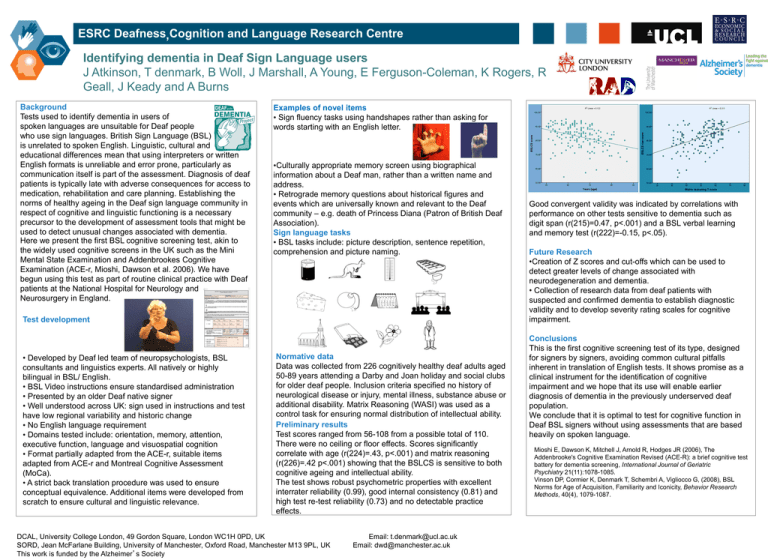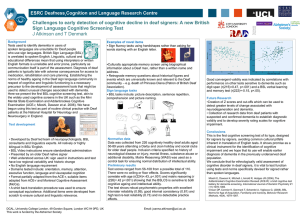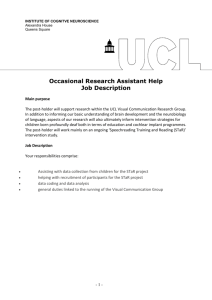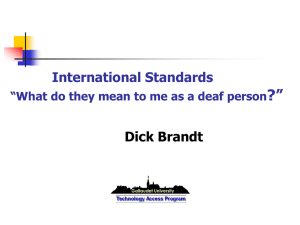Identifying dementia in Deaf Sign Language users
advertisement

Identifying dementia in Deaf Sign Language users J Atkinson, T denmark, B Woll, J Marshall, A Young, E Ferguson-Coleman, K Rogers, R Geall, J Keady and A Burns Background Tests used to identify dementia in users of spoken languages are unsuitable for Deaf people who use sign languages. British Sign Language (BSL) is unrelated to spoken English. Linguistic, cultural and educational differences mean that using interpreters or written English formats is unreliable and error prone, particularly as communication itself is part of the assessment. Diagnosis of deaf patients is typically late with adverse consequences for access to medication, rehabilitation and care planning. Establishing the norms of healthy ageing in the Deaf sign language community in respect of cognitive and linguistic functioning is a necessary precursor to the development of assessment tools that might be used to detect unusual changes associated with dementia. Here we present the first BSL cognitive screening test, akin to the widely used cognitive screens in the UK such as the Mini Mental State Examination and Addenbrookes Cognitive Examination (ACE-r, Mioshi, Dawson et al. 2006). We have begun using this test as part of routine clinical practice with Deaf patients at the National Hospital for Neurology and Neurosurgery in England. Examples of novel items • Sign fluency tasks using handshapes rather than asking for words starting with an English letter. •Culturally appropriate memory screen using biographical information about a Deaf man, rather than a written name and address. • Retrograde memory questions about historical figures and events which are universally known and relevant to the Deaf community – e.g. death of Princess Diana (Patron of British Deaf Association). Sign language tasks • BSL tasks include: picture description, sentence repetition, comprehension and picture naming. Test development • Developed by Deaf led team of neuropsychologists, BSL consultants and linguistics experts. All natively or highly bilingual in BSL/ English. • BSL Video instructions ensure standardised administration • Presented by an older Deaf native signer • Well understood across UK: sign used in instructions and test have low regional variability and historic change • No English language requirement • Domains tested include: orientation, memory, attention, executive function, language and visuospatial cognition • Format partially adapted from the ACE-r, suitable items adapted from ACE-r and Montreal Cognitive Assessment (MoCa). • A strict back translation procedure was used to ensure conceptual equivalence. Additional items were developed from scratch to ensure cultural and linguistic relevance. Normative data Data was collected from 226 cognitively healthy deaf adults aged 50-89 years attending a Darby and Joan holiday and social clubs for older deaf people. Inclusion criteria specified no history of neurological disease or injury, mental illness, substance abuse or additional disability. Matrix Reasoning (WASI) was used as a control task for ensuring normal distribution of intellectual ability. Preliminary results Test scores ranged from 56-108 from a possible total of 110. There were no ceiling or floor effects. Scores significantly correlate with age (r(224)=.43, p<.001) and matrix reasoning (r(226)=.42 p<.001) showing that the BSLCS is sensitive to both cognitive ageing and intellectual ability. The test shows robust psychometric properties with excellent interrater reliability (0.99), good internal consistency (0.81) and high test re-test reliability (0.73) and no detectable practice effects. DCAL, University College London, 49 Gordon Square, London WC1H 0PD, UK SORD, Jean McFarlane Building, University of Manchester, Oxford Road, Manchester M13 9PL, UK This work is funded by the Alzheimer’s Society Email: t.denmark@ucl.ac.uk Email: dwd@manchester.ac.uk Good convergent validity was indicated by correlations with performance on other tests sensitive to dementia such as digit span (r(215)=0.47, p<.001) and a BSL verbal learning and memory test (r(222)=-0.15, p<.05). Future Research •Creation of Z scores and cut-offs which can be used to detect greater levels of change associated with neurodegeneration and dementia. • Collection of research data from deaf patients with suspected and confirmed dementia to establish diagnostic validity and to develop severity rating scales for cognitive impairment. Conclusions This is the first cognitive screening test of its type, designed for signers by signers, avoiding common cultural pitfalls inherent in translation of English tests. It shows promise as a clinical instrument for the identification of cognitive impairment and we hope that its use will enable earlier diagnosis of dementia in the previously underserved deaf population. We conclude that it is optimal to test for cognitive function in Deaf BSL signers without using assessments that are based heavily on spoken language. Mioshi E, Dawson K, Mitchell J, Arnold R, Hodges JR (2006), The Addenbrooke's Cognitive Examination Revised (ACE-R): a brief cognitive test battery for dementia screening, International Journal of Geriatric Psychiatry 21(11):1078-1085. Vinson DP, Cormier K, Denmark T, Schembri A, Vigliocco G, (2008), BSL Norms for Age of Acquisition, Familiarity and Iconicity, Behavior Research Methods, 40(4), 1079-1087.




